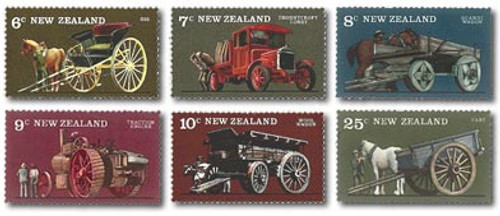Issue information
Gig - 6c
The gig and its four wheeled counterpart, the buggy, were the utility vehicles of the New Zealand farming community from the time of the development of roads until the advent of the motorcar. Drawn by a light harness horse, the gig's light construction allowed quick transport for the farmer and his family.
Thornycroft Lorry (1923) - 7c
It is not known when the first motor lorry was imported into New Zealand, but its usefulness had been well established by 1912, when much wool was being carried by motor lorry. It was in the country areas beyond the railheads that the motor lorry made its greatest contribution. The model for this stamp is a Thornycroft B T lorry, manufactured at Basingstake in England, designed to carry a load of 2.5 tons, and with a governed maximum speed of 18 mph. The Thornycroft is one of many makes of lorry which were replacing horse drawn vehicles on New Zealand's roads in the 1920s.
Scandi Wagon - 8c
The Scandi, or bush wagon, was developed by the Scandinavian immigrants who were brought to New Zealand in 1872, and established the settlements of Dannevirke and Norsewood in the Seventy-Mile Bush in Southern Hawke's Bay. The difficult conditions encountered by the settlers demanded a wagon of rugged construction. The Scandi is simple in design, has no springs, a low deck, and is characterised by the unusual wheel construction.
Traction Engine - 9c
When the first traction engines arrived in New Zealand has not been established, but engines dating from the 1880s can still be seen. Great numbers were imported from the 1890s until the late 1920s. Traction engines were used extensively in all parts of the country, on road haulage, agricultural work, timber milling, and general contracting. Because the traction engine could haul considerable loads, it was soon in competition with the railways. It was almost indispensable for hauling heavy equipment from railheads, and reduced the time, and, usually the costs, of hauling wool from back-country sheep stations.
Wool Wagon - 10c
Wool wagons drawn by teams of bullocks or horses, were once a common sight in New Zealand. They were used extensively to haul the valuable wool clip from the back-country sheep stations to the coast. A high, wide deck allowed a greater number of wool bales to be carried, and kept the load above water level when fording rivers, and when the wagon was driven into the sea to load ships standing off the beach.
Cart - 25c
The farm cart has been an essential piece of the European farmer's equipment for centuries, and it was no less indispensable to the New Zealand farmer in the horse-drawn era. Probably the most common of all farm vehicles, it was used for everyday haulage around the farms and on the roads. Drawn by a single draught horse, it carried a wide variety of loads, from fence-posts to fertilizer, milk cans to mangolds, livestock to lumber.
Stamp bulletin
This stamp issue first appeared in New Zealand Post Stamp Bulletin No. 15 in April 1976.
Acknowledgments: Bulletin scanned and provided by John Biddlecombe of the New Zealand Society of Great Britain. Their web site offers further information useful to those interested in the stamps and postal history of New Zealand. Link: http://www.nzsgb.org.uk/
Technical information
| Date of Issue: | 7 April 1976 |
|---|---|
| Designers: | G Fuller, Havelock North |
| Printers: | Harrison and Sons, England |
| Stamp Size: | 40.64mm x 24.13mm |
| Sheet Size: | 100 stamps per sheet |
| Process: | Lithography |
| Perforation Gauge: | 13.75 x 13.25 |
| Paper Type: | Harrison and Sons, unwatermarked |

